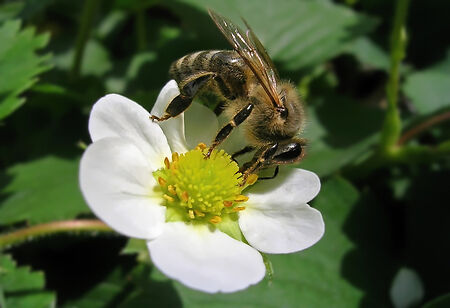
Can Artificial Intelligence Track the Insect Pollinators?


To meet the world's food, fuel, and fiber demands, farmers must engage in agricultural advances and modern farming techniques to use fewer natural resources, such as water, land, and energy. Other buzzwords in contemporary agriculture include agribusiness, intensive farming, organic farming, and sustainable agriculture. As we all know, modern agriculture makes food more accessible, increases the amount of food available, ensures food safety, enhances sustainability, and generates more biofuels. Nevertheless, because it is based on high input-high output systems that use hybrid seeds of high-yielding varieties and ample irrigation water, fertilizers, and pesticides, it also contributes to environmental problems.
An innovative method for tracking the crucial insect pollinators for farming is provided by artificial intelligence (AI). At a strawberry farm in Victoria, Australia, researchers have set up tiny digital cameras and computers inside a greenhouse to monitor bees and other insects as they fly about pollinating flowers. The method promises to improve pollination efficiency—like how road monitoring may help traffic flow smoothly. This will make it possible to produce more food while using resources more effectively.
Food production needs to become more efficient and sustainable with a growing human population and limited natural resources. Precision agriculture powered by new technologies, like AI, can help secure future food production. Efficient pollination is crucial to produce healthy fruits, vegetables, legumes, and nuts. Optimal pollination requires just the right number of insect pollinator visits to flowers. Visits by ineffective insect pollinators can diminish the quality of food a flowering plant produces.
Direct eye observation or pan traps are typically used as monitoring approaches for insect pollination—both are time-consuming and labor-intensive. Moreover, it is impractical to gather data simultaneously across big farms without a huge number of experienced observers. But before a season's pollination window closes, such data are required to offer time-critical confirmation of the degree of crop pollination. Yet, a farm manager may get same-day information on crop pollination levels with digital technology.
Big Data with Advanced Software
With the amount of data a system gathers, it takes specialized software to monitor individual insects as they fly through intricate foliage accurately. Modern software can recognize insect movements within a video sequence, allowing farmers to avoid unintentionally counting numerous instances of a single bug traveling down the same path. This makes it possible to count insects accurately, analyze their kind (such as species), and keep track of their visits to flowers. Specialized software uses a hybrid detection technique to find and follow flowers and insects in films. In order to determine the exact locations of insects and the flowers they visit in the image, this model combines the AI-based object-recognition skills of deep learning utilizing a convolutional neural network with distinct foreground identification algorithms. The software includes features to make data processing more efficient and save on computer power.
It requires specialized algorithms to precisely track individual insects as they fly through complex foliage due to the volume of data collected. With software that can identify insect motions within a video clip, farmers can prevent accidentally counting several instances of a single bug traveling down the same path. This enables precise insect counting, analysis of their kind (such as species), and monitoring of their flower visits. A hybrid detection technique is also used to locate and track flowers and insects in movies.
This approach combines AI-based object-recognition capabilities of deep learning with a convolutional neural network with different foregrounds to pinpoint the precise locations of insects and the flowers they visit.
Which Insects Drive Pollination?
In the monitored area, visits by honeybees to flowers are generally more frequent than visits by other insects. According to a scientific study, around 68 percent of the flowers had at least four insect visits to ensure full fertilization. Although honeybees were the primary pollinators, visits by other insects frequently led to a bloom receiving the required four visits, potentially increasing agricultural yield. For instance, knowing how well a crop has been pollinated enables growers to change the location and quantity of hives to make up for pollination deficiencies. Also, to encourage or discourage insect visits from particular directions, farmers may open or close the sides of greenhouses. To encourage insects to investigate crop sections with new growth, they could decide to add flowers that attract insects.
Productivity through Pollination
In order to preserve and improve the stability of pollination services across time, the study emphasizes the significance of wild insect diversity and recommends that Ireland's agricultural industry be encouraged to promote general insect pollinator diversification. The University College Dublin researchers discovered significant variations in honeybee visitation rates amongst apple varieties, highlighting the need for a deeper comprehension of regionally specific crop pollination needs. They indicate that flower flies, hoverflies, and solitary bees could be effective pollinator management targets in Ireland since solitary bees were shown to carry a lot of pollen while solitary bees had high floral visitation rates.